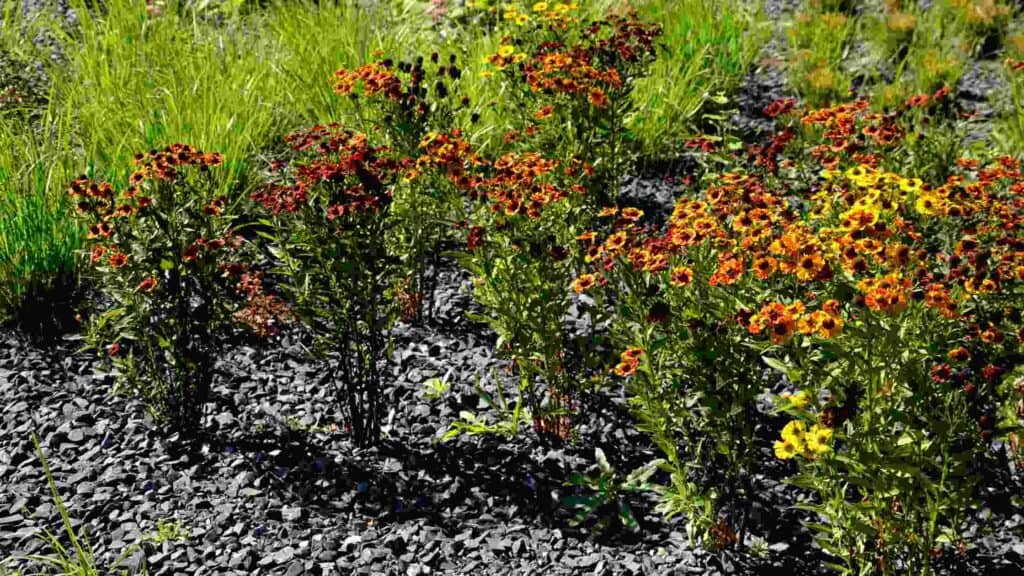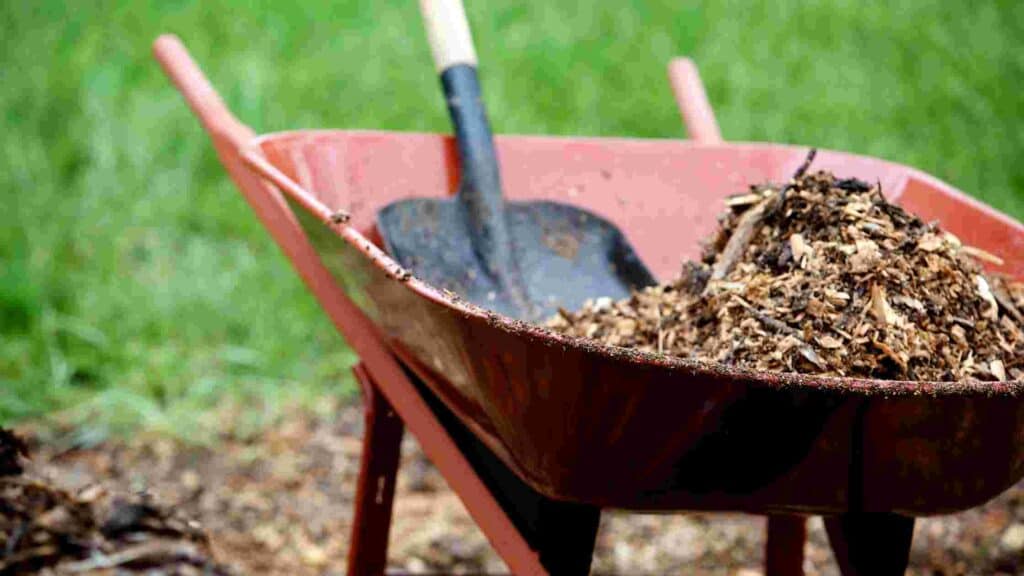Mulch is what we sprinkle over our garden beds for protecting plants, It adds nutrients and gives our outdoor spaces that extra decorative touch. But have you ever wondered how deep should mulch be?
We’ve got you covered with all the dirt on mulching!
How Deep Should Mulch Be?
The golden rule is 2 to 3 inches after settling, but let’s start with 4 inches. As you water your garden beds, those lighter mulch particles will sink into the soil, so you’ll need to top it up from time to time.
The depth of your mulch layer can make or break your green haven. Too much, and your plants suffocate; too little, and they’re left high and dry.
The depth of the mulch also depends on the type of mulch you’re using.
Too much mulch acts like a no-entry sign for water and sunlight, resulting in your plants withering away.
On the flip side, going too light on the mulch will have it flying away with the wind or washed away with the rain.
Before we get our hands dirty, a little prep work goes a long way. Get rid of as many weeds as possible, because once you lay that mulch down, you cannot do much!
Make sure not to cover the base of your garden plants; they need their breathing space.
Don’t worry about the old mulch; it’s still got a job to do! Just let it decompose into the soil like compost (find out what to do with old mulch in the garden).
Pebble/Stone Mulches

If you’re all about the pebbles and stones, this type doesn’t play by the same rules as the others. A 2-inch layer is more than enough to add some glitz and glam to your garden.
And if you’ve got kids around, keep an eye on those pebbles. Kids are known to swipe them for gifts or playtime treasures!
Woodchip Mulches
Now, if you’re using woodchip-based mulches, they’re like shapeshifters. They may look deep at first, but they’ll settle in over time.
So be generous with your woodchip layer, and after settling, you’ll find a sweet spot at around 2 to 3 inches deep.
Benefits Of Mulching
Mulching can do wonders for your garden. The benefits depend on the type of mulch you choose to rock.
Take pea straw, for instance – it’s not just about keeping the soil from drying out. As it breaks down, it generously gives your soil extra nutrients.
But before that happens, you might find yourself with a bunch of pea plants popping up. Most people consider them weeds and remove them from the mulch.
If you’re living in a colder climate or experiencing a chillier season, mulch becomes your plants’ cozy blanket, protecting their roots from the cold snap and keeping them well-insulated.
If you’re into aesthetics (and who isn’t?), then pine or wood chips and crushed stones are your go-to mulching materials.
Not only do they make your garden look fabulous, but they also prevent weed growth. Plus, they’re slow decomposers, so they stick around longer, giving you more bang for your buck.
Mulch Types
Now that we’ve laid the groundwork for mulch, let’s dig into the different types available.
1. Somewhat Degradable Mulch
If you prefer a bit of texture in your mulch, these chunky mulches are for you! Bark, wood chips, pine needles, and cocoa shells fall into this category.
They’re like the strong, silent types – breaking down slowly and adding some serious personality to your garden beds.
2. Biodegradable Mulch: Nutrient Boosters
These mulches break down over time, releasing their goodness into the soil. Think pine straws, hay, lawn clippings, and pea straw.
Not only do they give your plants a nutrient boost, but they’re also good at retaining moisture – keeping your garden happy and hydrated.
3. Decorative/Non-Organic Mulch
These types consist of crushed rocks, pebbles, and even rubber pieces (more on playgrounds than gardens). Sure, they may not provide nutrients or decompose, but they look good and are low-maintenance.
When Is The Best Time To Mulch?

The right timing is crucial with mulching. In winter, a thin layer won’t cut it; your plants need some serious protection from the cold. So pile it on!
But come spring, don’t go overboard. Too much mulch will give your plants a heatwave they don’t want. As summer approaches, thicker mulch is better, helping your plants stay hydrated in the scorching heat.
Keep your distance from plant trunks and trees; placing the mulch too close can kill them.
Here’s an in-depth article on when is the best time to mulch.
FAQs
1. Is 3 inches of mulch too much?
Three inches of mulch is not too much, but it’s important to avoid excessive depth, as it can lead to issues like waterlogging or root suffocation.
2. Is 1 inch of mulch enough?
One inch of mulch is not enough to provide adequate weed suppression and moisture retention. Two to three inches is usually recommended.
3. What should I put down before mulching?
Before mulching, you can put down a layer of weed barrier fabric or newspaper to help prevent weed growth.
4. How to lay mulch over old mulch?
When laying mulch over old mulch, first rake the existing mulch to loosen it and then add a fresh layer on top.
5. Should I water mulch after putting it down?
After putting down mulch, it’s a good idea to water it lightly to help it settle and prevent it from blowing away.
6. How to put down mulch in flower bed?
To put down mulch in a flower bed, spread it evenly around plants, making sure not to pile it against the plant stems.
7. What is the best tool to spread mulch?
The best tool to spread mulch is a wheelbarrow, a shovel, and a rake for even distribution.
8. How to lay mulch over weeds?
To lay mulch over weeds, consider using a thick layer (3-4 inches) or applying a weed barrier before mulching.
9. Is there a mulch depth calculator?
Yes, there are mulch depth calculators available online that can help you determine the right amount of mulch for your garden or landscape.
10. How deep should rubber mulch be for playground?
For playgrounds, rubber mulch depth should be at least 6 inches to provide sufficient impact-absorbing properties and ensure safety.
You may also be interested in checking out the rubber mulch calculator.
Final Thoughts: How Thick Should Mulch Be?
For a healthy, tidy garden, mulching is totally worth it. But the amount you need depends on the type of mulch and your garden goals. The recommended depth for mulch is typically 2 to 4 inches.
Biodegradable mulches are like farmland feasts for your soil, offering nutrients galore. They’re also water-saving agents in the summer and insulation material in the winter.
When in doubt, consult your local garden suppliers! They know your climate and soil like the back of their green thumbs. They’ll hook you up with the perfect mulching ingredients for your gardening needs.
Now go forth, mulch like a pro, and watch your garden bloom! Happy gardening!
